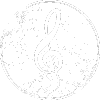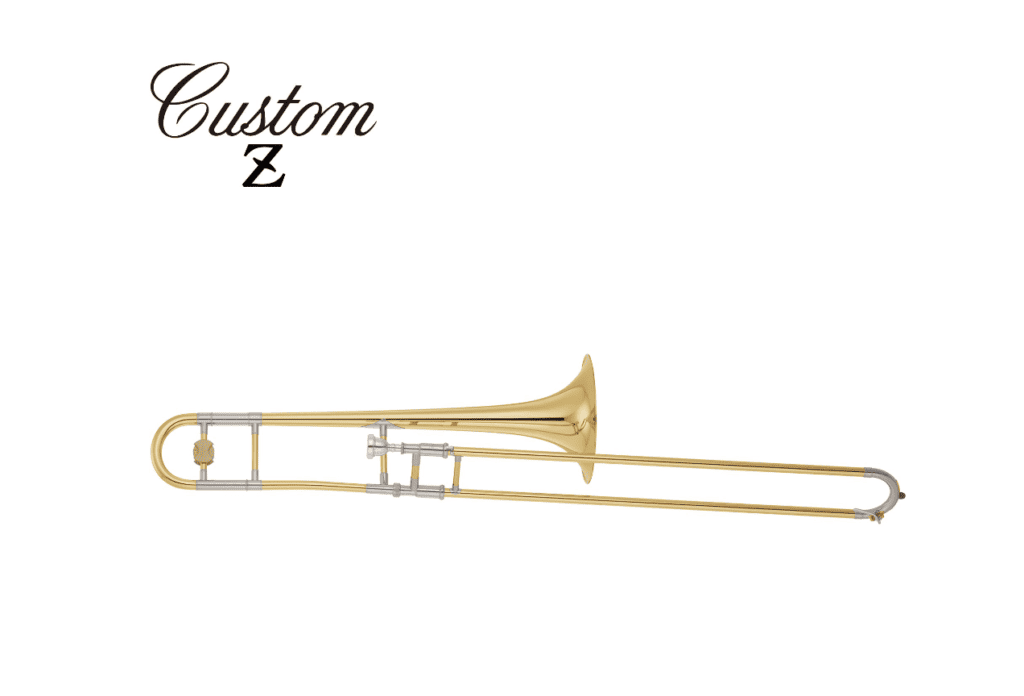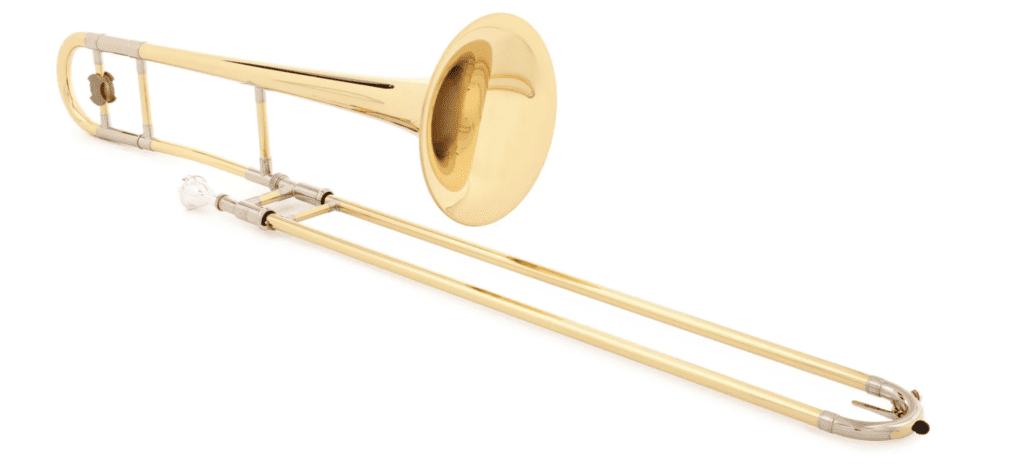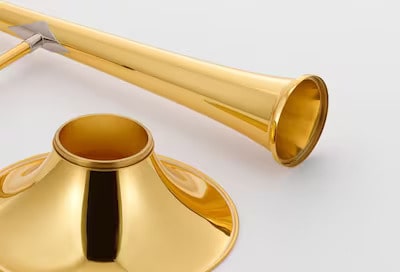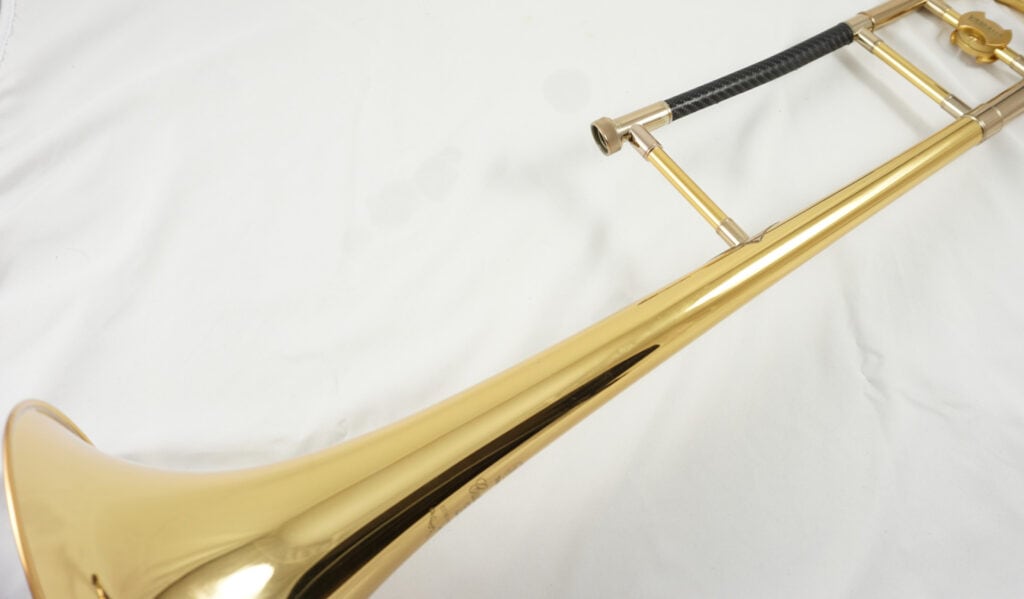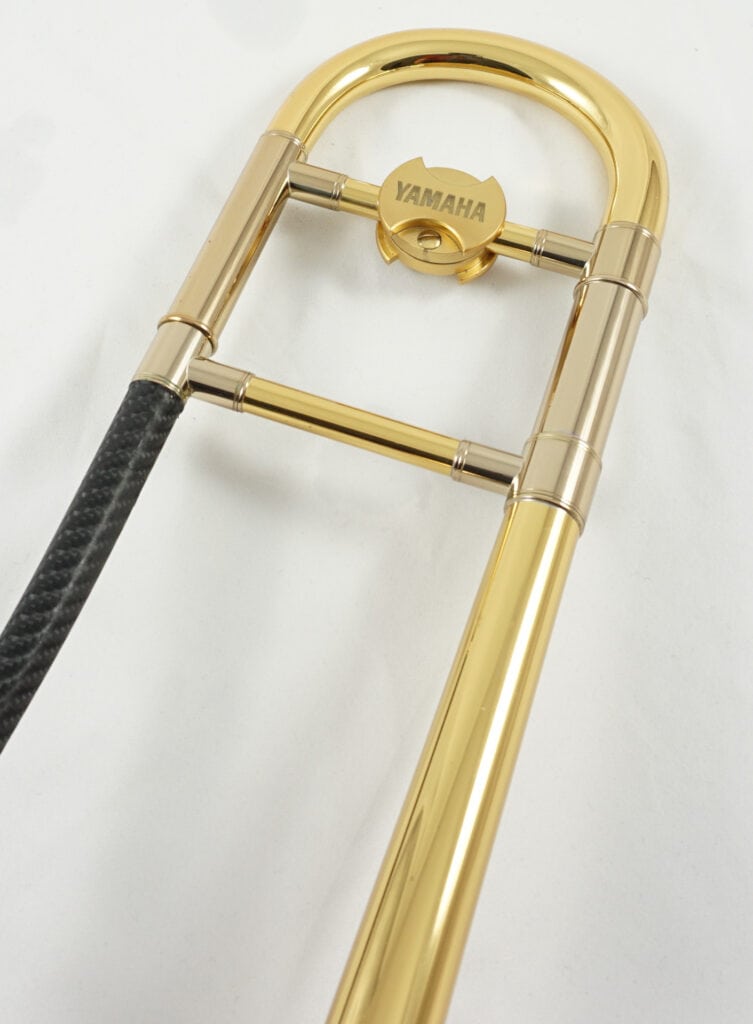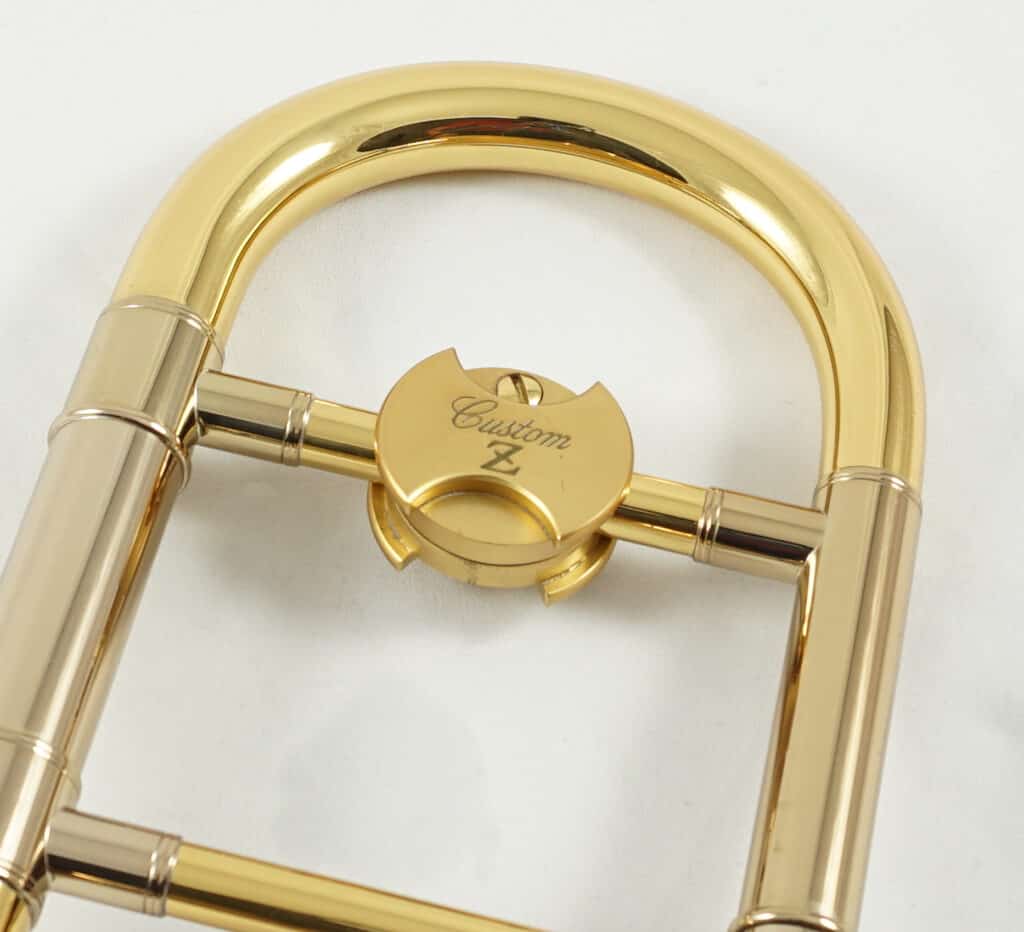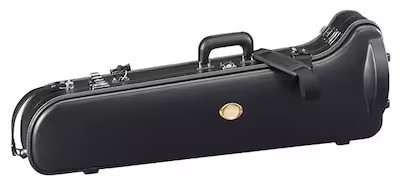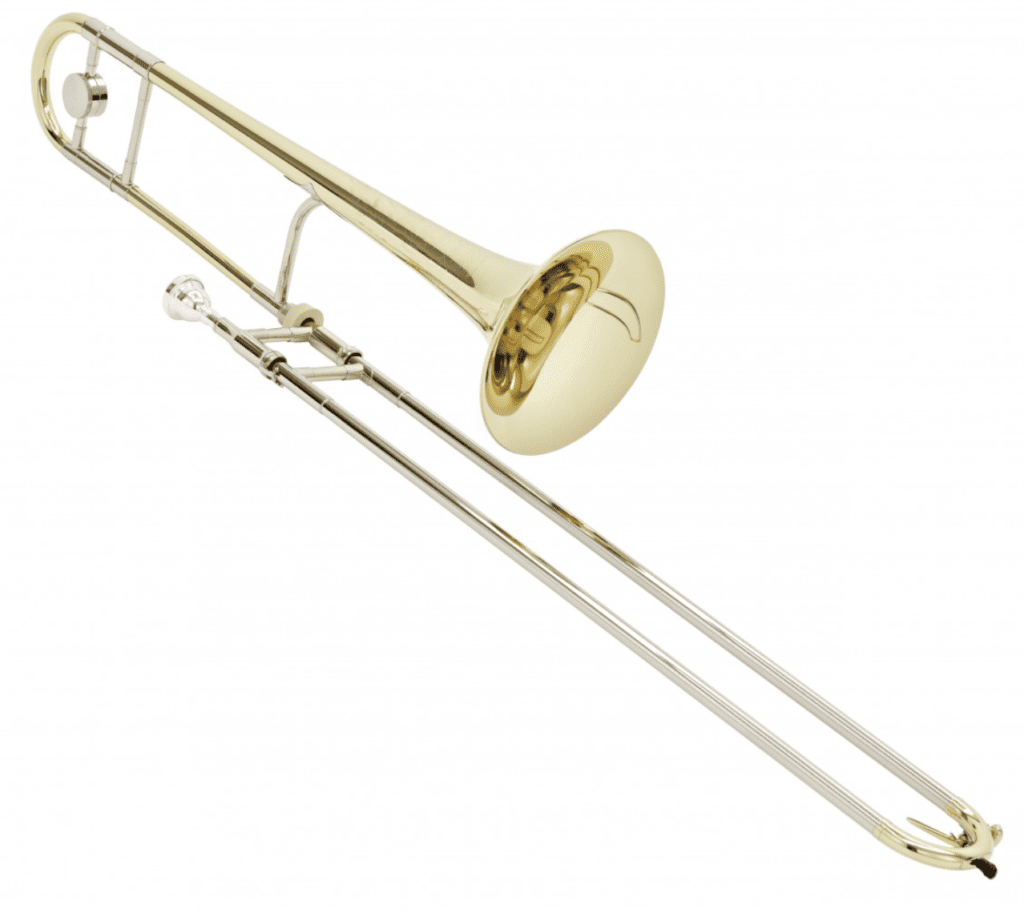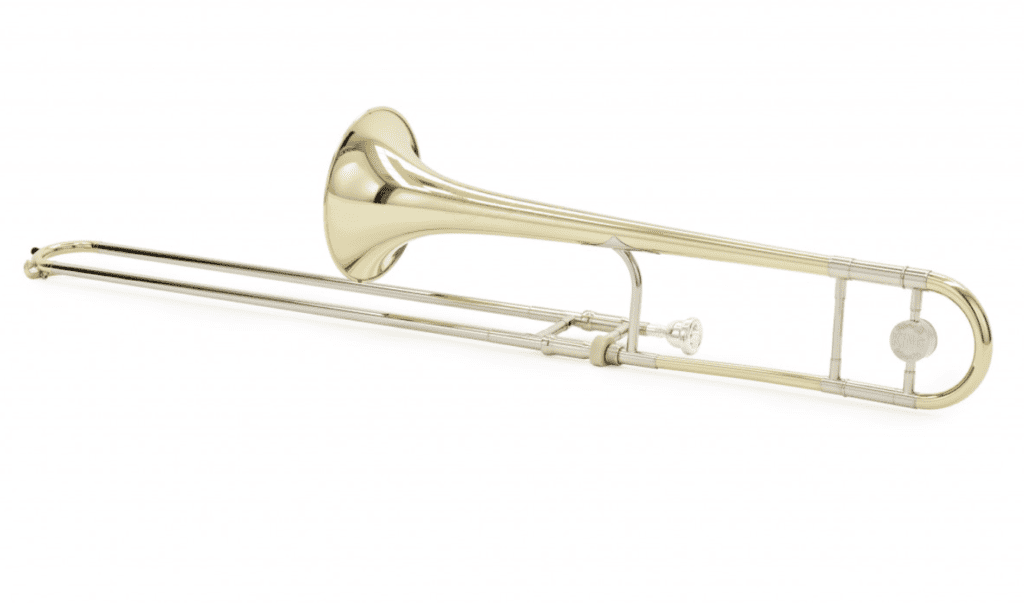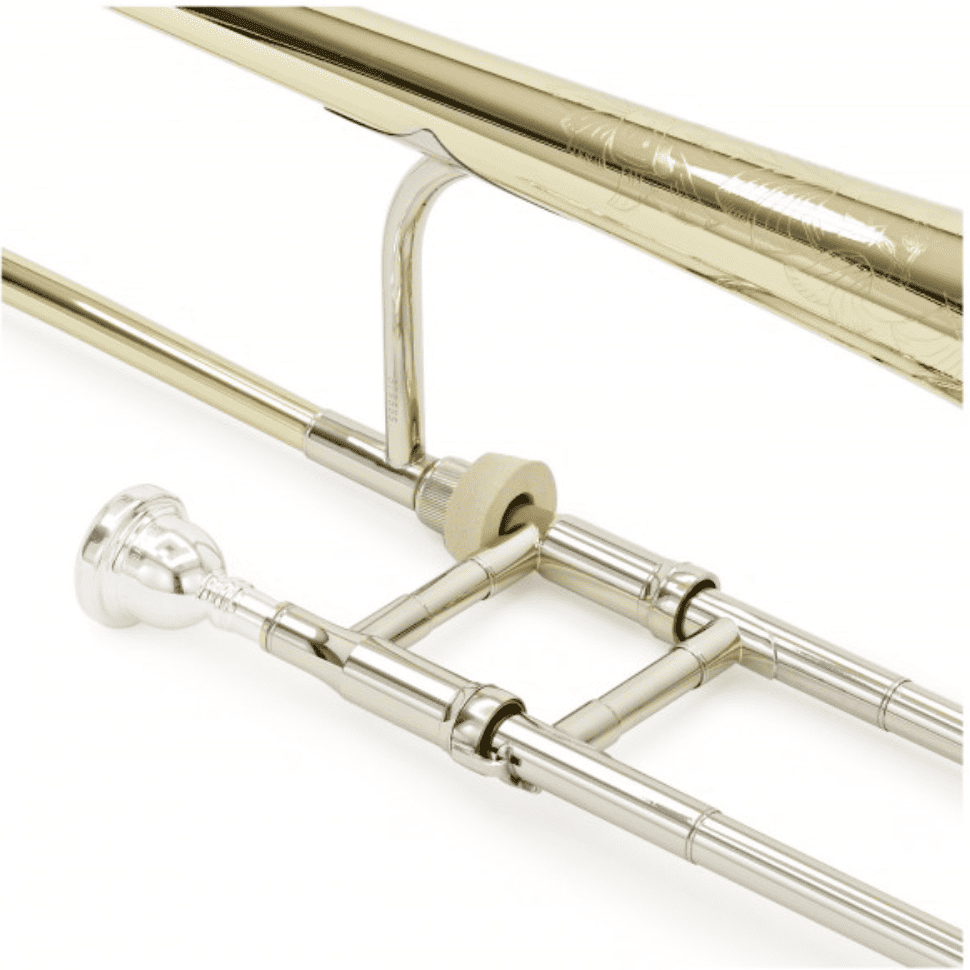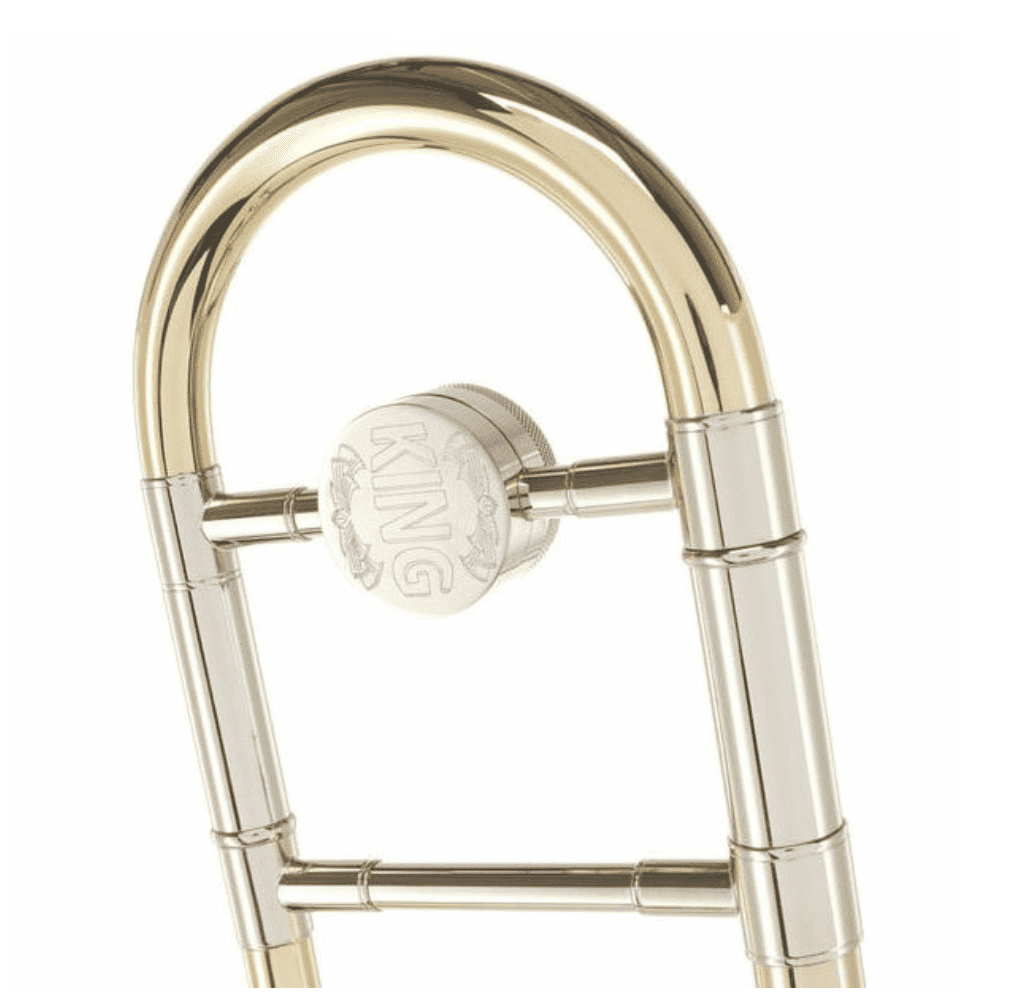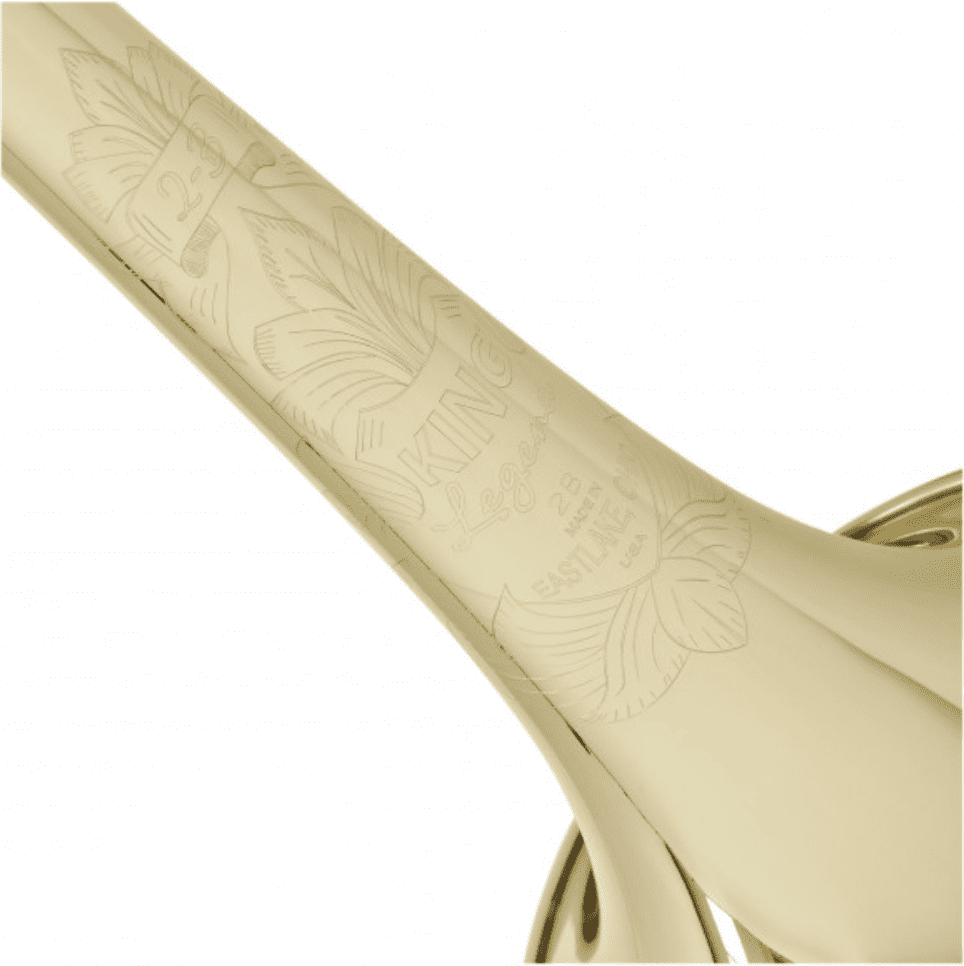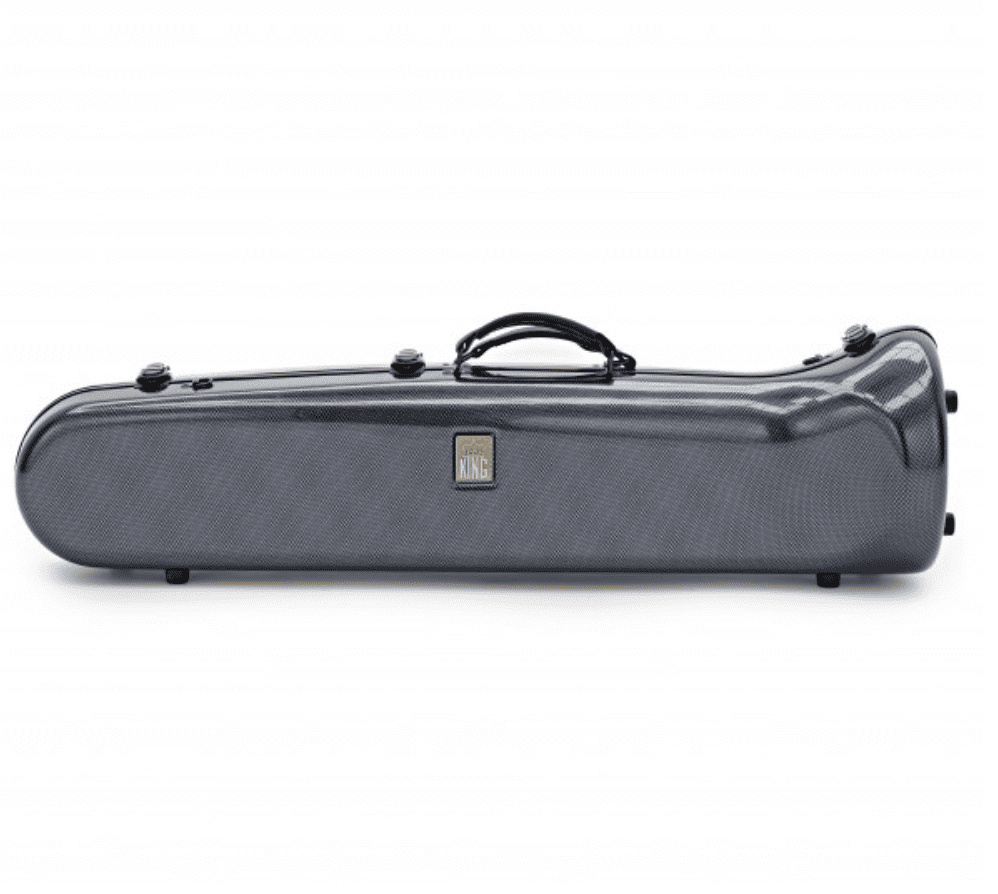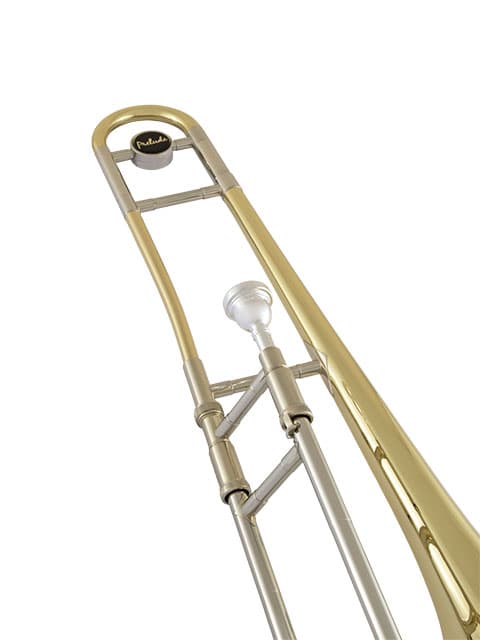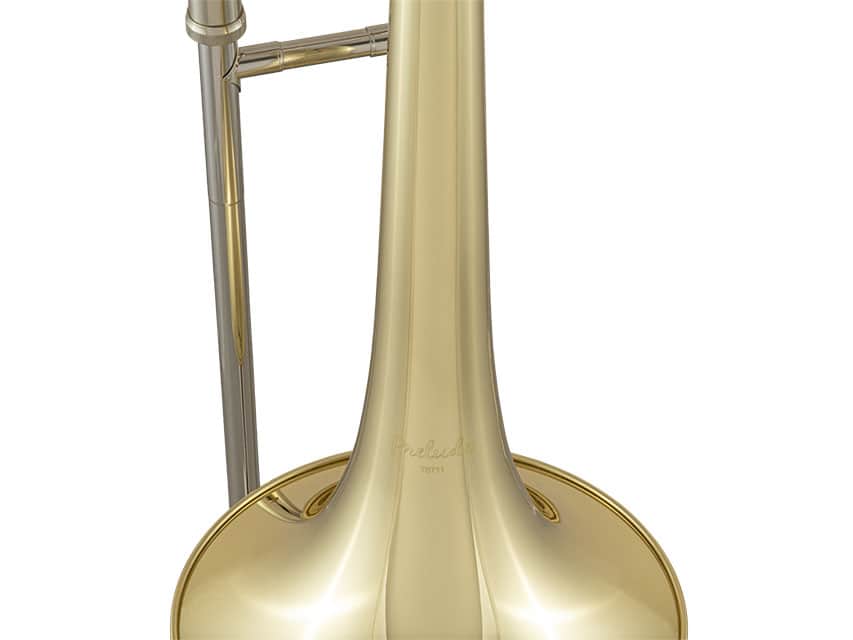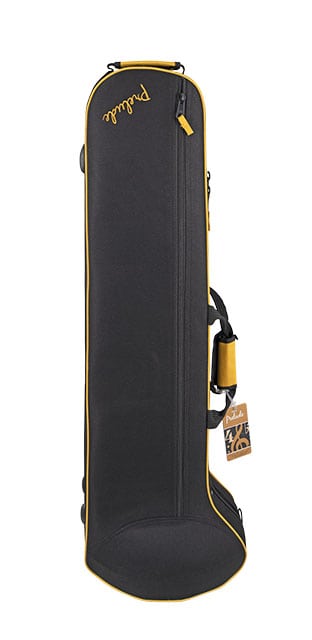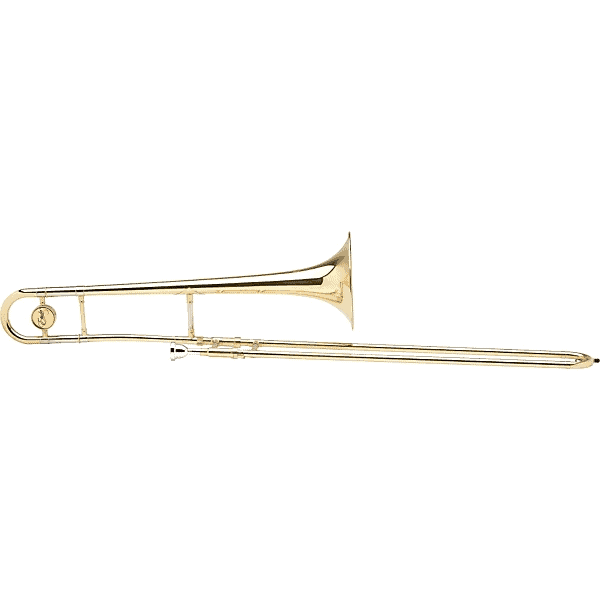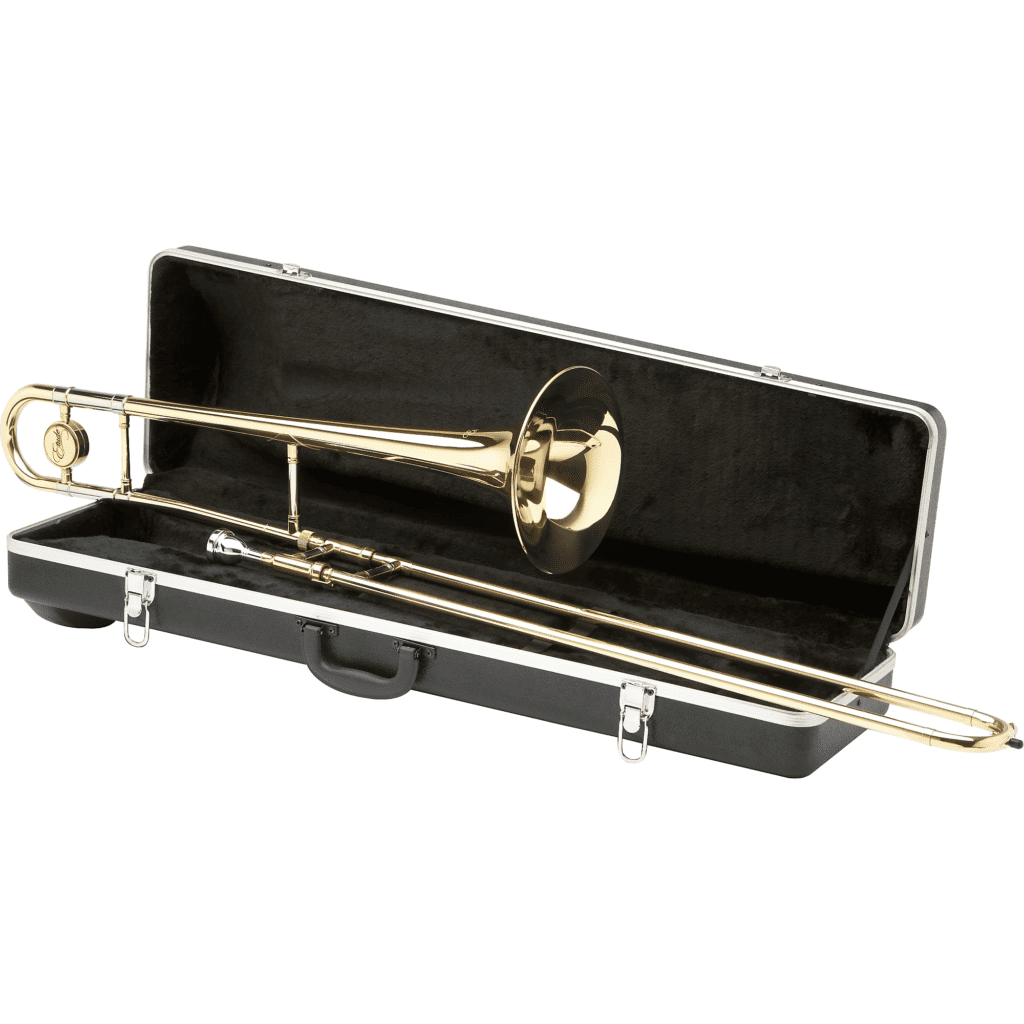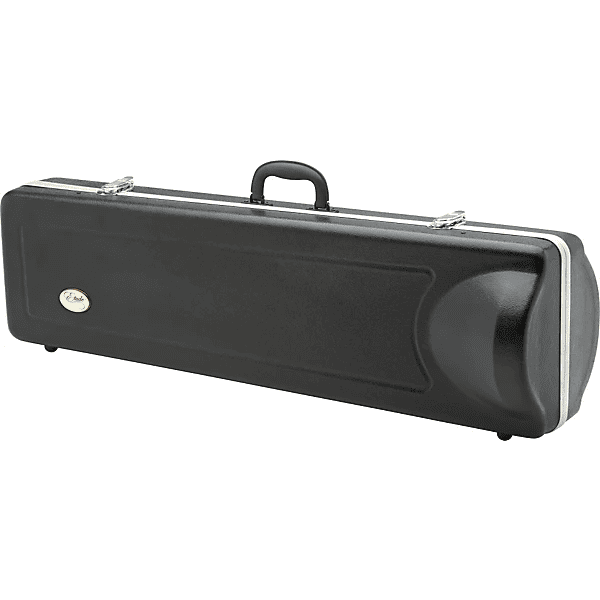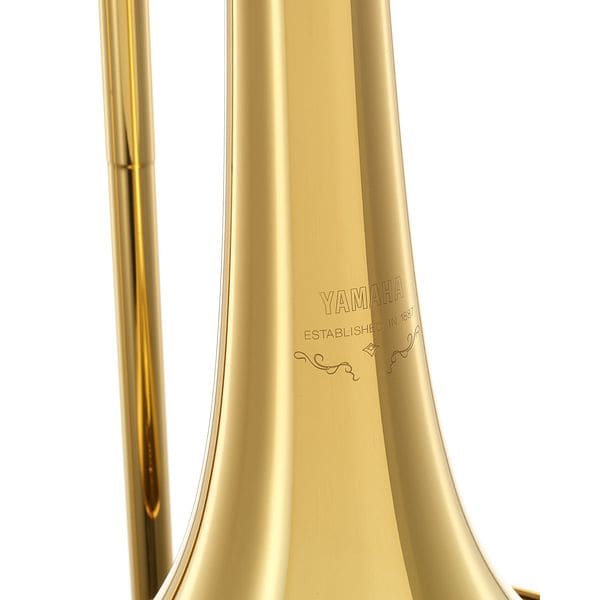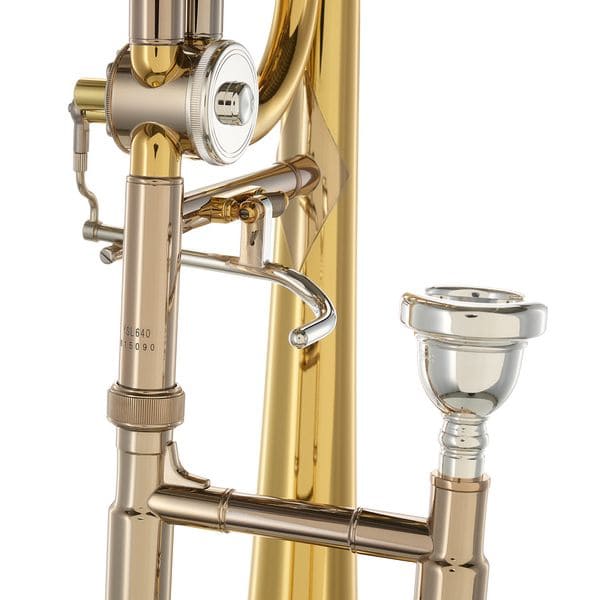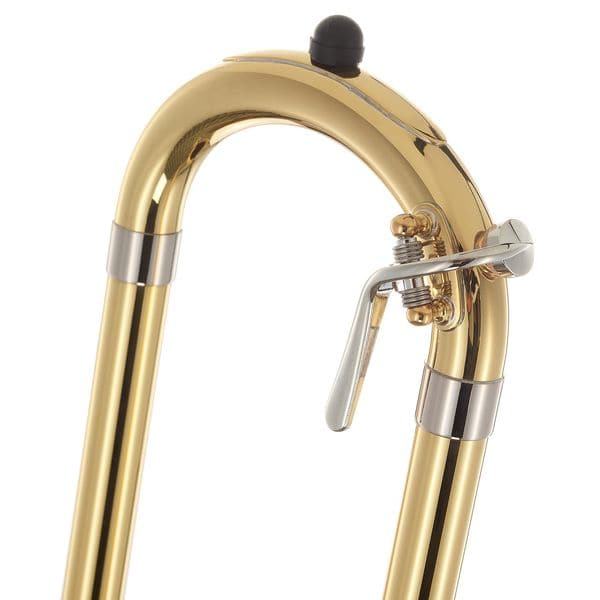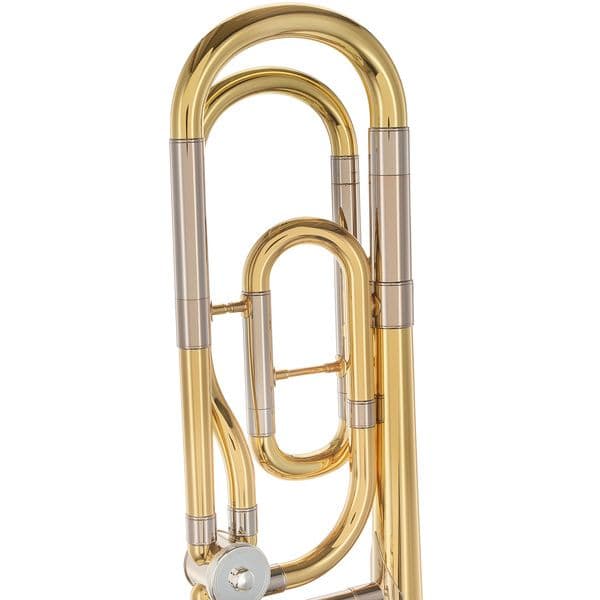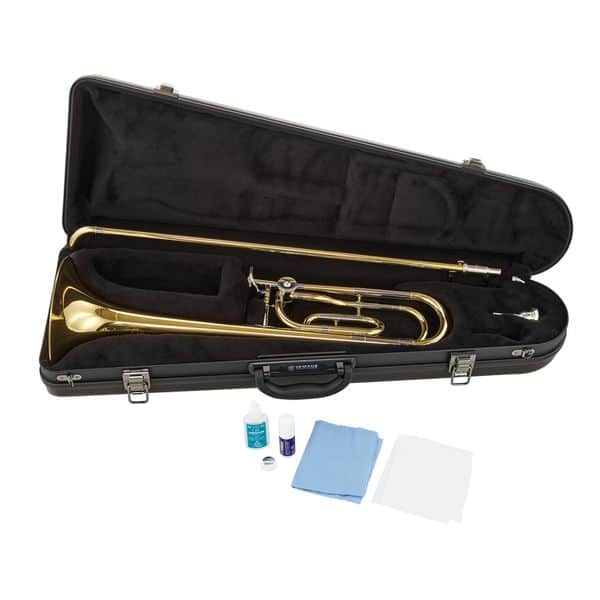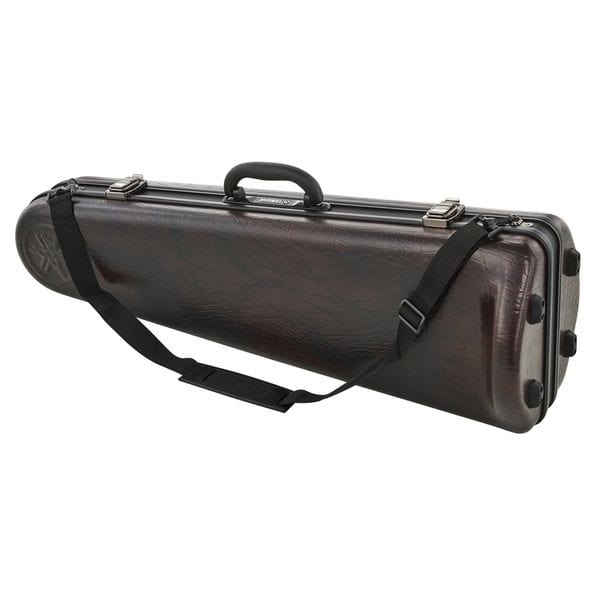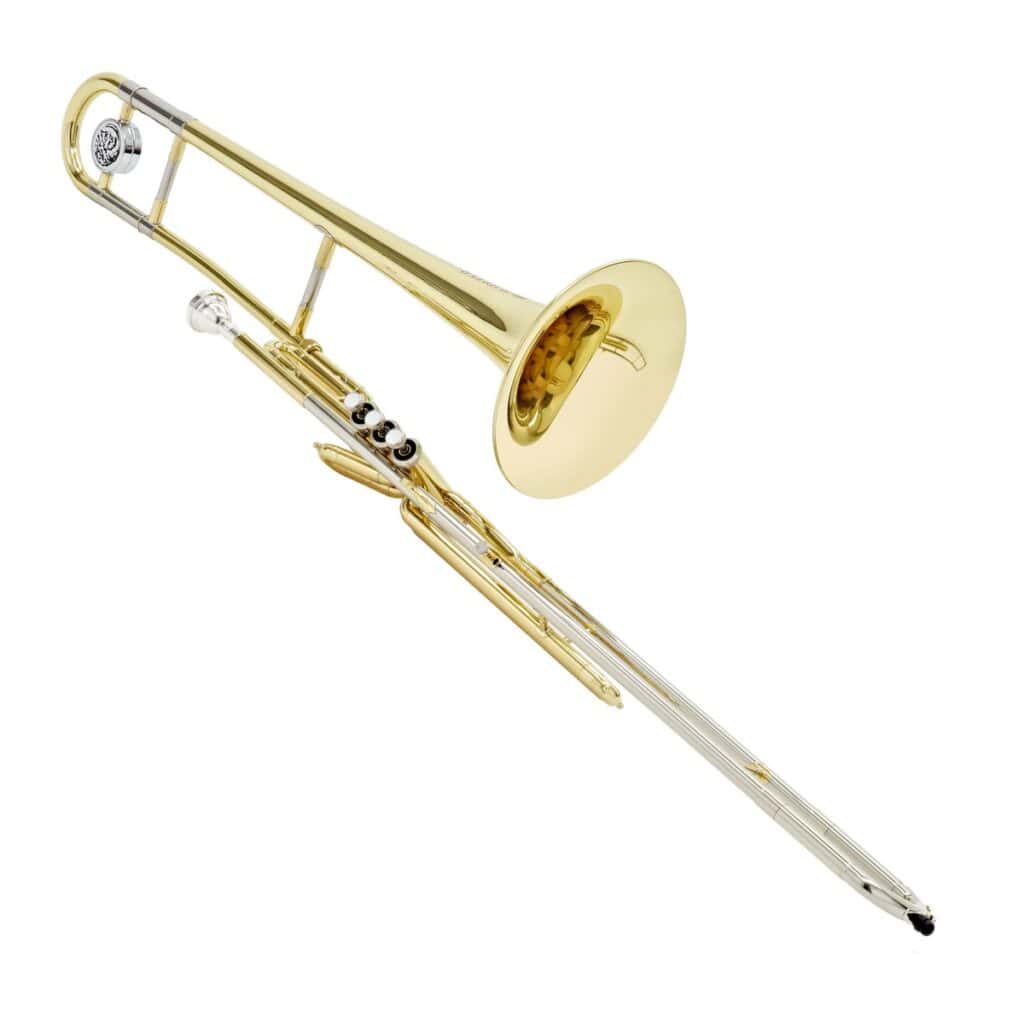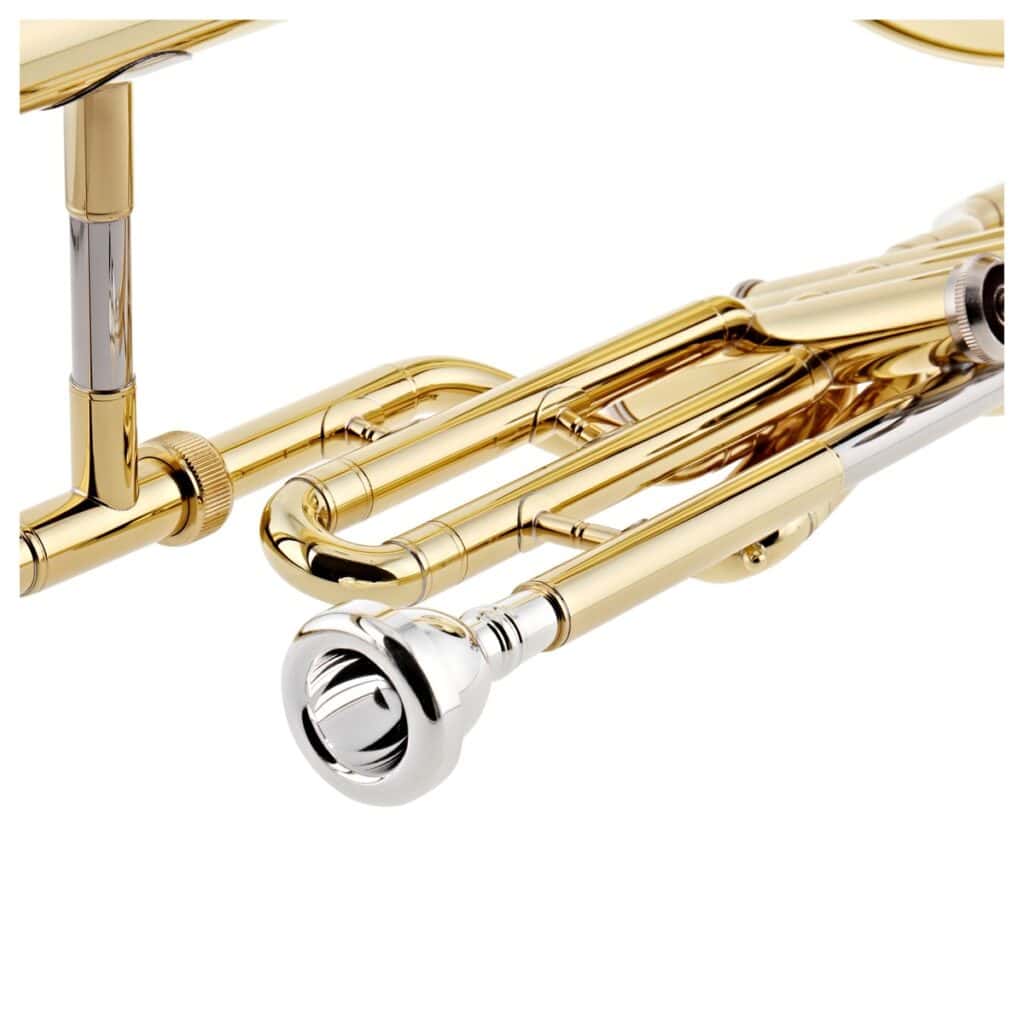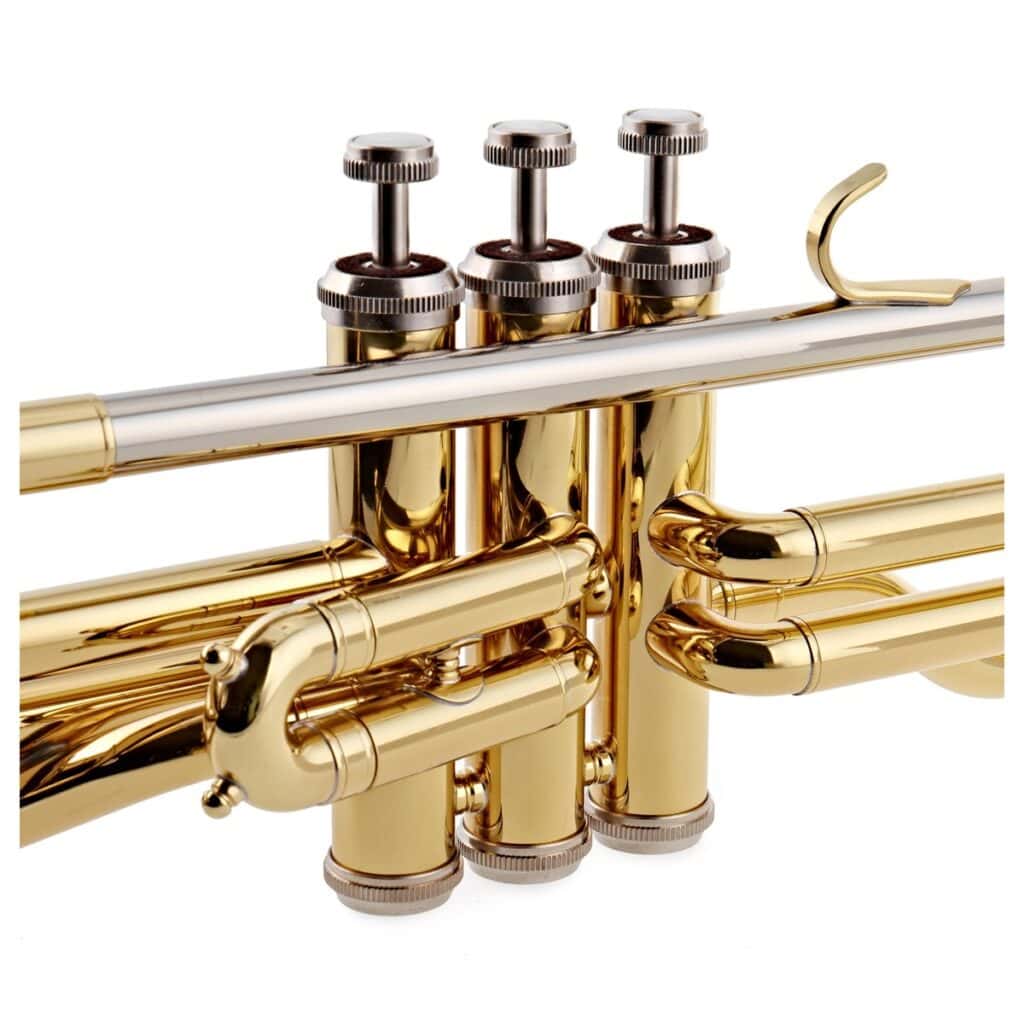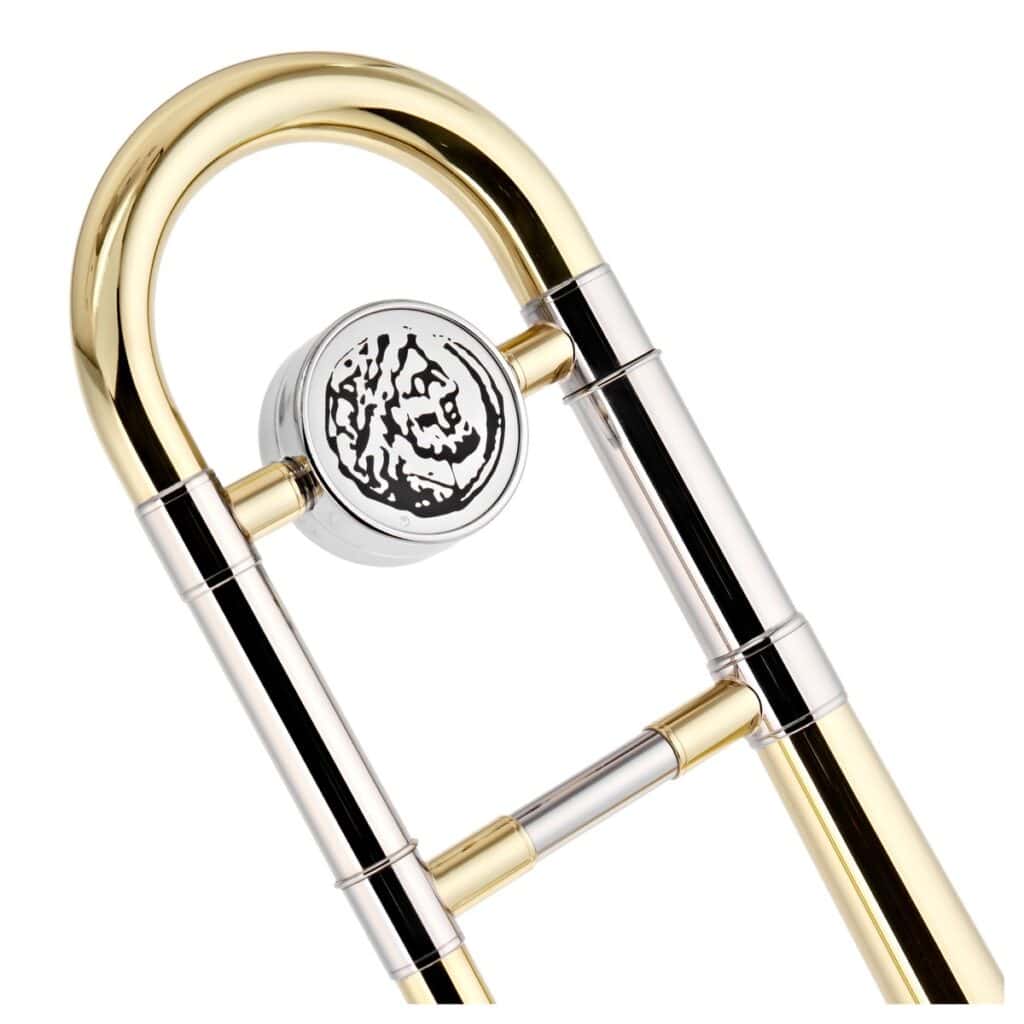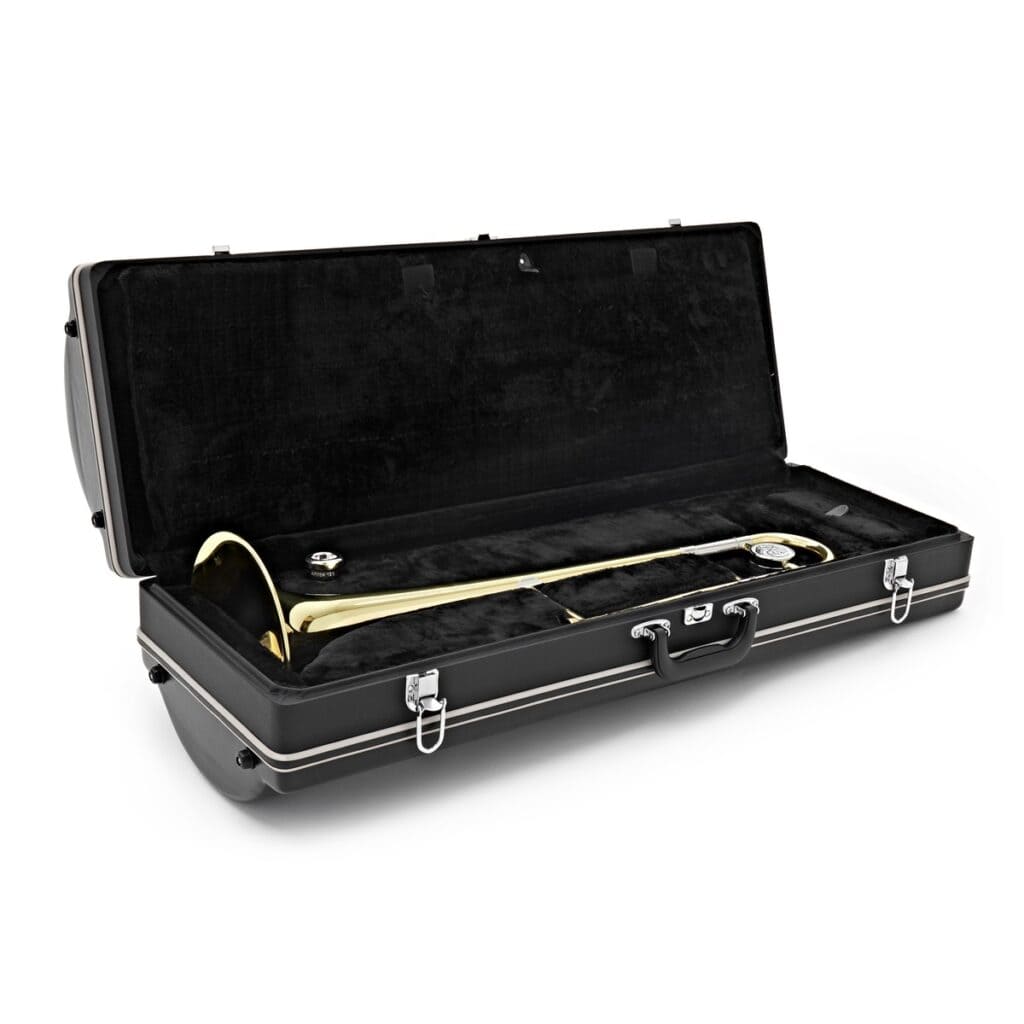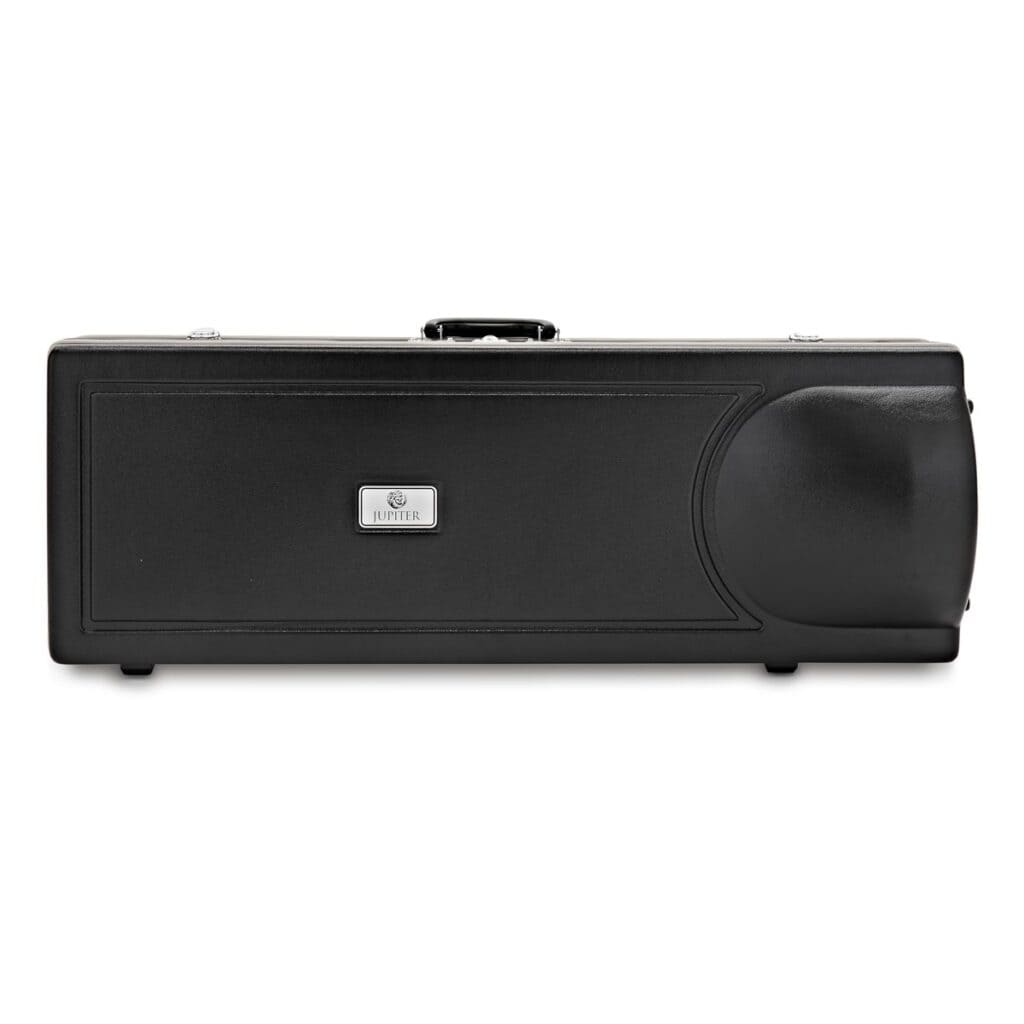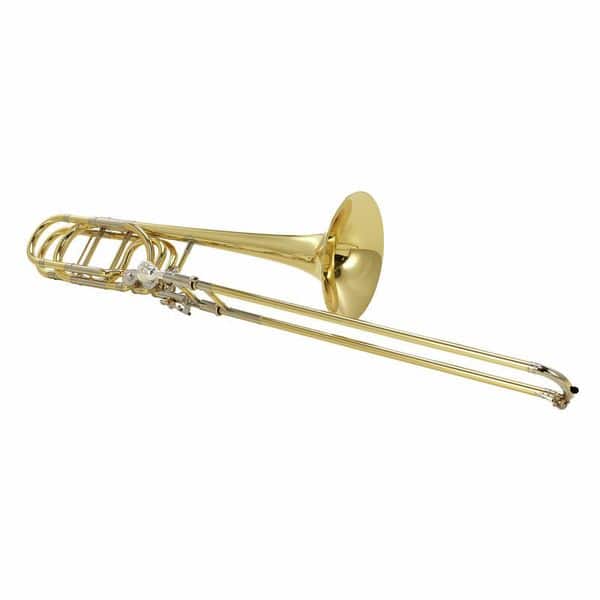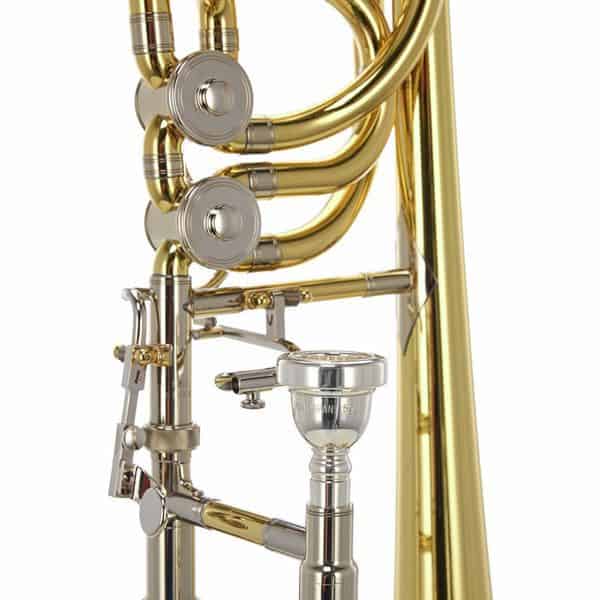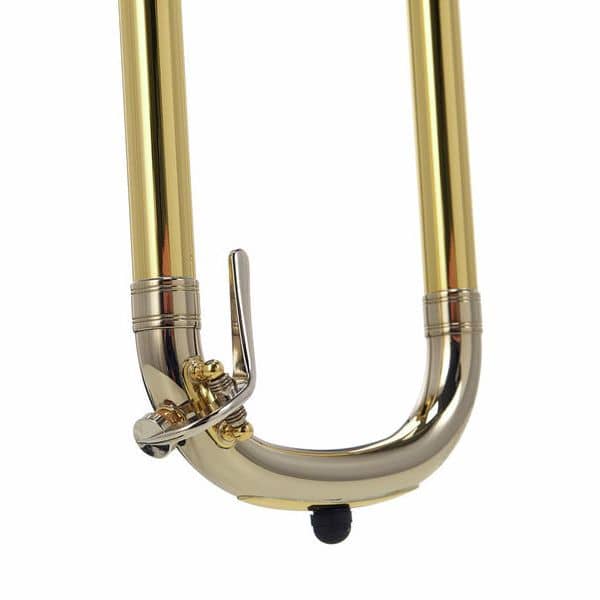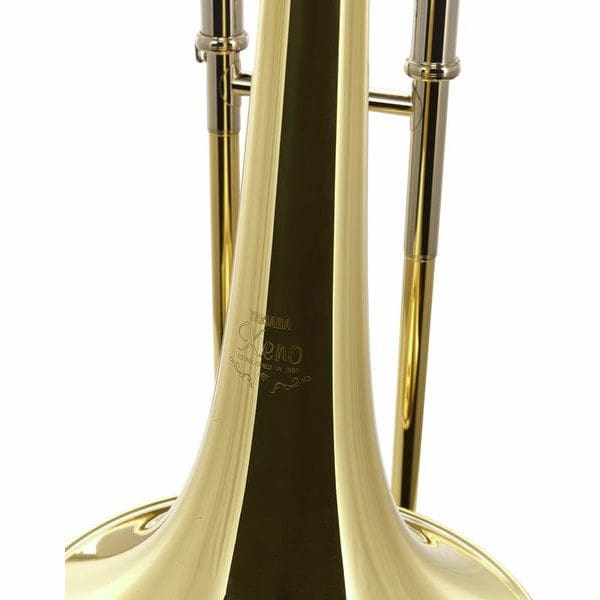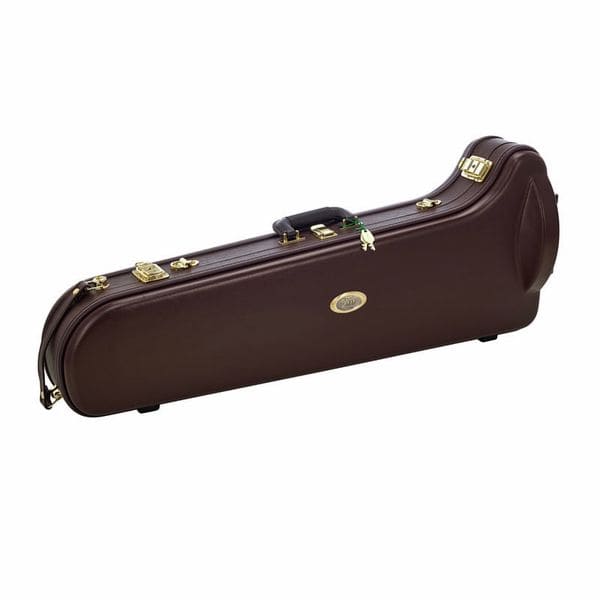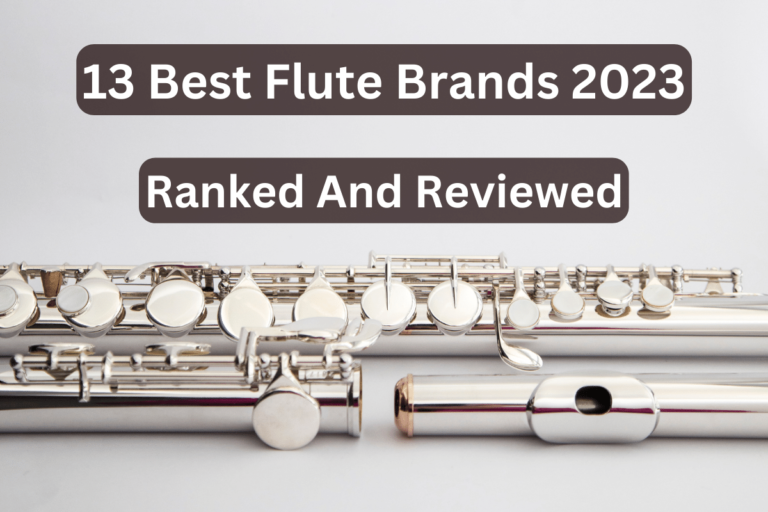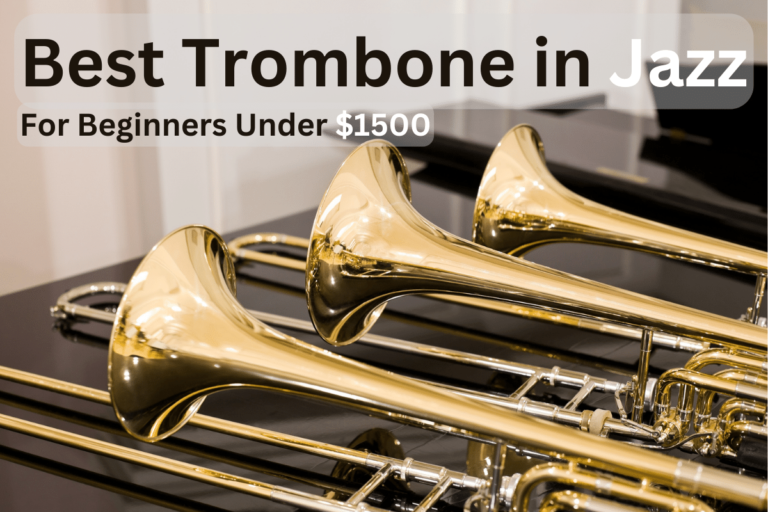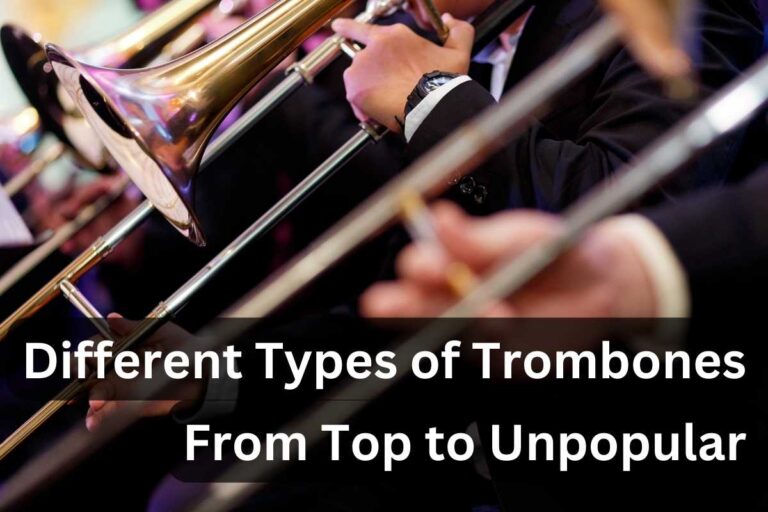What is a Tenor Trombone: Range, Parts, Best Models 2025
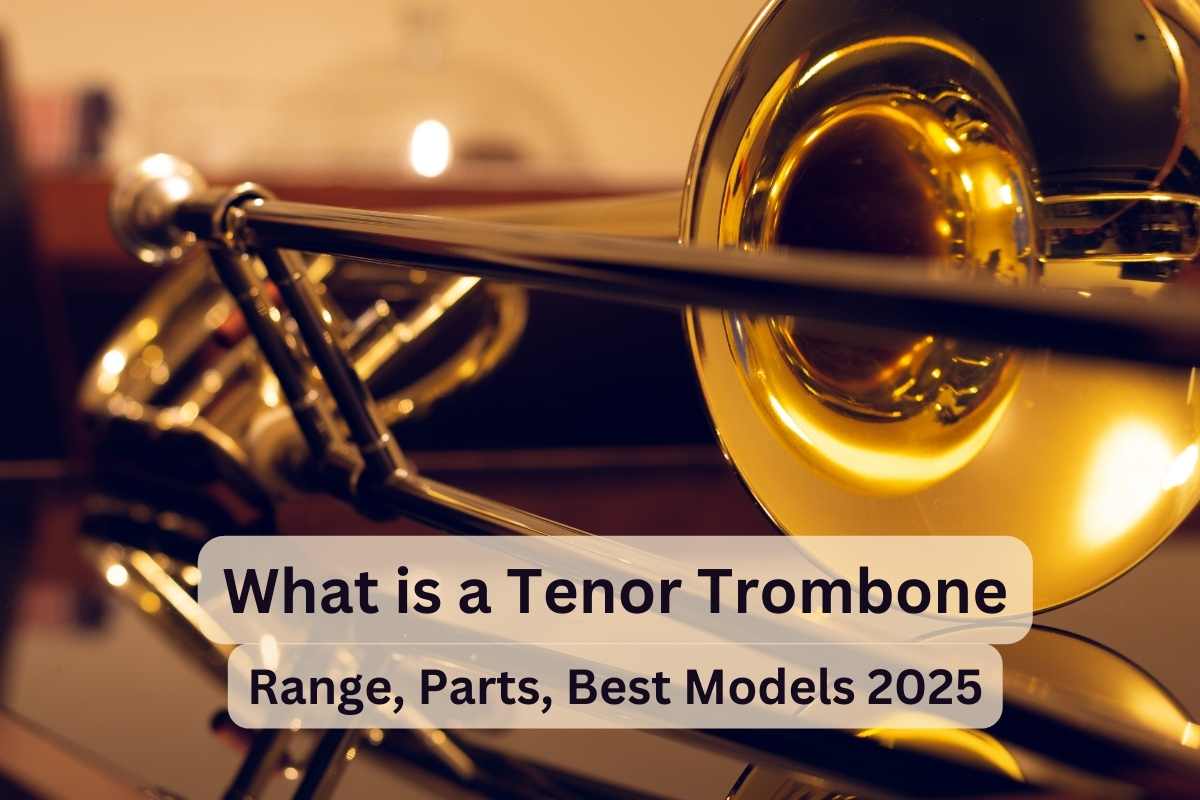
The tenor trombone — a popular brass instrument — makes a bigger and louder sound than other trombones. Many jazz bands (since the mid-1800s) have used this instrument in their music.
Famous players like J.J. Johnson and Tommy Dorsey have inspired many musicians to start playing. Whether this is your first trombone (or your fifth one), this guide will help you.
Read about other “13 Different Types of Trombones: From Top to Unpopular 🎺“
What You’ll Learn
This guide covers the basic parts of tenor trombones. You’ll learn about the different types you can buy. We’ll also look at the top models (for 2025) to help you make a good choice.
The guide will help you understand the range of sounds tenor trombones make. Pick the right trombone for your needs and budget!
What Is a Tenor Trombone?
A tenor trombone has a cylindrical bore. Its sound comes from air flowing through the tubing. Players adjust the slide or use three valves (on valve trombones) to produce different notes.
This instrument typically plays within the range of E2 to F5. It has a bright yet powerful sound. You can often hear its bold tone in orchestral concerts, jazz, and marching bands.

The tenor trombone has a long history. It was played in military bands, large ensembles, and brass choirs.
Michael Praetorius first wrote about the tenor trombone in 1619. In his book “Syntagma Musicum,” he called it “a very long and large instrument about three or four feet long”.
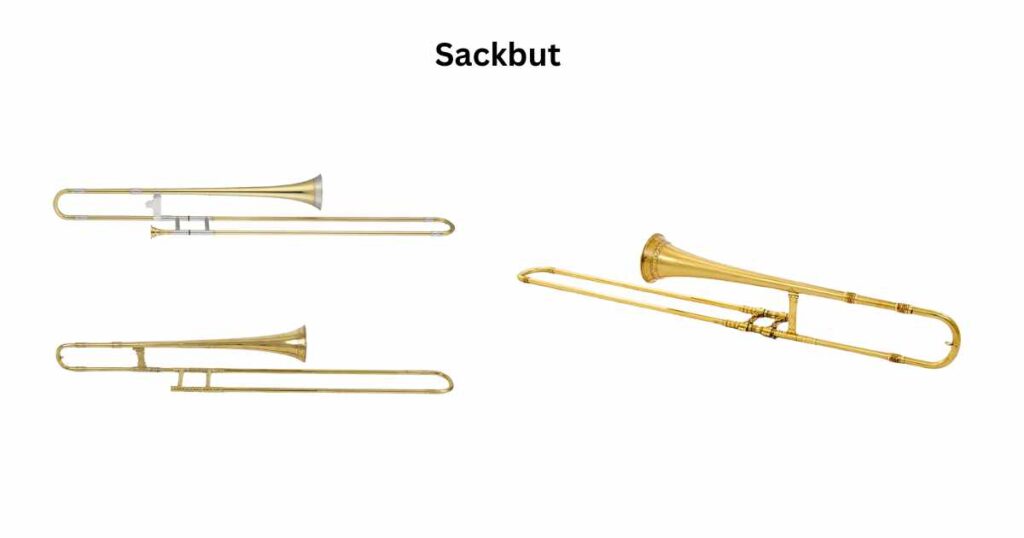
The trombone came from an old medieval instrument called a sackbut. Sackbuts looked like today’s trombones but had smaller parts. When people started using it again in the 1600s, they gave it a new name — trombone.
In the 1700s, composers like Georg Philipp Telemann and Ludwig van Beethoven began using tenor trombones in their music. They wanted to add more depth to their songs (in my opinion, this made the music richer). This made the trombone more popular with other composers.
Tenor and Valve Trombones Parts
Tenor trombones are popular instruments found in brass bands and orchestras. They often take center stage at concerts (in my experience). These instruments have long tube bodies with valves that make sound when you blow air into them.
The main parts of a trombone include the bell, slide, and mouthpiece. Players use their left hand for the valve section and right hand for the slide.

Tenor Trombones: A Simple Guide
Tenor trombones are popular instruments found in brass bands and orchestras. They often take center stage at concerts (in my experience). These instruments have long tube bodies with valves that make sound when you blow air into them.
The main parts of a trombone include the bell, slide, and mouthpiece. Players use their left hand for the valve section and right hand for the slide.
The Bell
The bell is the large flared end of a trombone. It makes the sound louder and creates warm tones. The bell’s shape sends sound in one direction instead of spreading it everywhere. Both size and design affect the trombone’s unique sound.
The Slide
The slide is like a long tube on the trombone. It has two sections joined by a telescoping joint. Players move the slide to change pitch when playing music. You can adjust the inner and outer parts for better tuning (something professional players do all the time).
The Mouthpiece
The mouthpiece is the small end where air enters to make sound. It has a metal cup, rim, and shank that fit tightly together. This prevents air from escaping — crucial for good sound!! The size and shape affect how much air goes in and how loud the sound is.
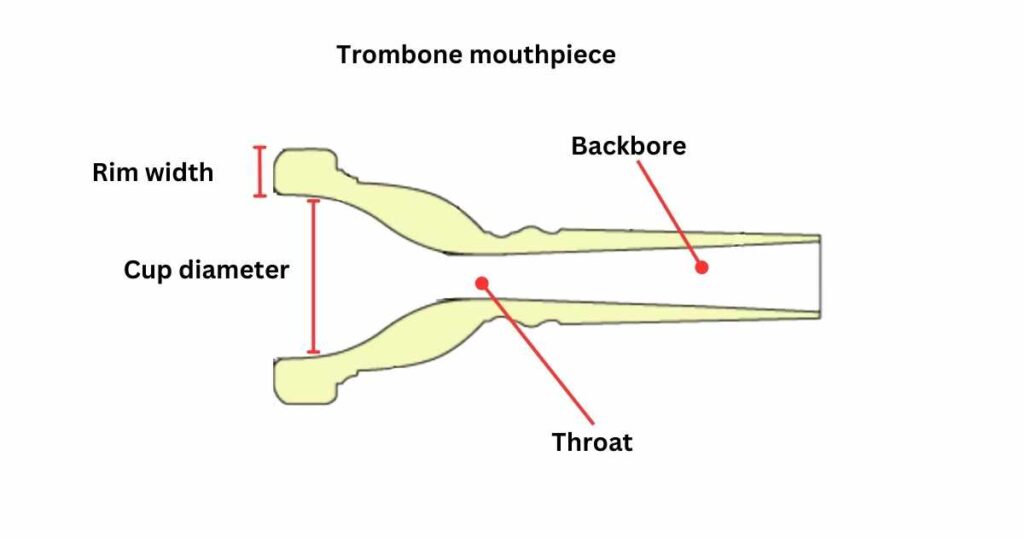
The Valve Section
The valve section works like a control center for air flow. It has three keys connected by slides. When you press a key, it opens or closes an air passage. This lets you change both pitch and tone of each note.
Check out my “Trombone Parts | The Best Complete Guide”.
Range of the Tenor Trombones
A trombone’s range refers to its notes-playable capacity. Trombones typically range in their playing range from the low E note below the bass clef up to high B flat above middle C, though experienced players might extend that up to F above B flat (a feat sometimes achievable with specific models that also boast trigger mechanisms that expand its lower range all the way down to C). Sounds pretty amazing, doesn’t it?

Extra tubing alters the range of the trombone, making its range lower than with standard tenor trombone. For instance, an F attachment (rotary valve) extends its range all the way down to C2 — one letter below where E previously resided on bass clef staff or two octaves on an 88-key piano keyboard.
Bass trombones with two triggers have the capacity to produce low notes as low as F1, equivalent to C2 on a tenor trombone with an F-trigger; otherwise known as being in the first octave on the piano keyboard.

Alto trombones may not be widely found in modern music, but their slightly higher range than tenor trombones makes them worthwhile instruments to explore. Alto trombone goes as high as G5 for experienced players compared to G4 on tenor trombones – yet only differ because of a higher pitch; so experienced alto players could theoretically reach even higher notes with this instrument!
Soprano trombone parts, similar to trumpet parts, can either be written in concert pitch or transposed to B, with E3 to C6 as their range of function. Soprano trombones (sometimes referred to as slide trumpets) are tuned in Bb and generally cover similar ranges as Bb trumpets — though not often utilized.
Tenor Trombone Slide Chart
A trombone’s sound pitch can be adjusted using its slide, which adjusts tubing length by sliding between the 1st (closest to the player) and the 7th position numbered 1–7 on its scale of movement, each one representing one note from harmonic series.
The slide positions on each chart are determined by harmonic series; since there are no visible markers on tubing, players relying on touch rather than sight can achieve accuracy with position adjustments. Please see our Trombone Slide Chart Diagram for standard fingering patterns and finger positions.
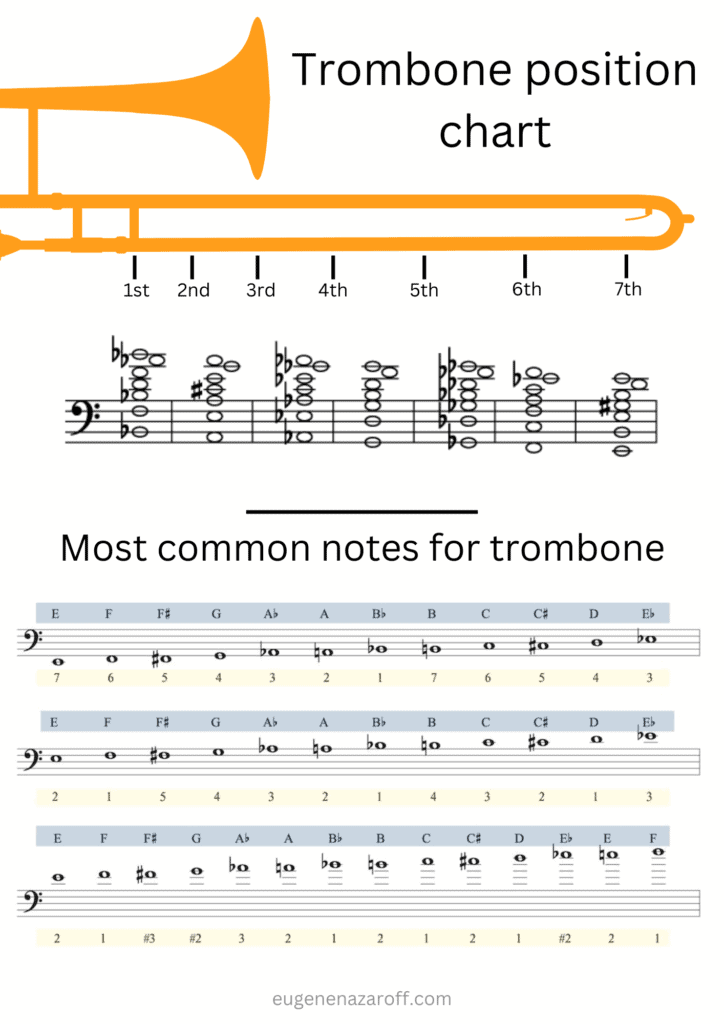
At the bottom of this chart are trombone notes displayed relative to their position on the slide. Keep in mind that the 3rd position falls a few mm before rather than directly under the bell. Note how each position’s gap grows larger due to acoustics laws which dictate that neighboring tone frequencies do not follow simple multiples of each other.
Looking to master trumpet theory? Check out our Trombone Slide Charts Guide — packed with both printable and downloadable resources that can help.
What Are The Best Tenor Trombones?
When it comes to jazz tenor horn playing, some models really shine: The Yamaha King 2B stands out with its dual bore design for precise control and warm tones; for smooth, responsive playability — there’s the Yamaha YSL-640 F Attach and medium bore model; with bass trombones — Yamaha YBL-830 model stands out with its large bore and superior tone quality; should these models make your list?
M Davis and other legendary jazz trombonists favor straight horns because of their crisp and focused sounds that cut through intricate arrangements in big bands. If you want to unlock your full potential – whether a novice or veteran player — keep reading and look into some great tenor trombones that could really elevate your game!
Yamaha YSL-891Z Custom Jazz Trombone
Overview
The Yamaha YSL-891Z custom tenor trombone stands as one of the iconic instruments in trombone history, boasting its luxurious golden lacquer finish and convenient balancer system to provide a smooth playing experience – not forgetting all its attractive features that turn heads wherever it goes!
A trombone bell is handcrafted using individual sheets of metal layered together for maximum authenticity and power, creating long lengthwise vibrations to produce its signature authentic tone. Crafted out of yellow brass hammered for fast response time and extra presence.
Andy Martin and Wycliffe Gordon, two extraordinary jazz trombonists, joined forces to design the Yamaha YSL-891Z trombone. It fulfills all the criteria for jazz trombonists – deep yet powerful tones with lightning fast response times. Two leadpipes – one for deep tones with the powerful flow; the other with bright tones for lightning-fast response time – make up this beast of an instrument!
Features
- Key: Bb (B flat)
- Two leadpipes for various jazz performances
- One-piece chrome-plated nickel-silver inner slide
- One-piece hammered yellow brass bell
- Bell size: 8″
- Bore diameter: .508″
- Japanese trombone brand
Pricing
Yamaha YSL-891Z Custom Jazz Trombone
Bottom Line
Yamaha YSL-891Z Tenor Trombone is more than an instrument; it’s an investment into your musical journey! New owners love its vibrant tones that recreate vintage jazz sounds while remaining extremely user-friendly for professional trombonists.
King 2B Legend Professional Tenor Trombones
Overview
The King 2B trombone stands out among cool jazz trombones due to its innovative dual bore design. This provides a more open sound and feels with greater air requirements required for effective playing. Its bore creates larger sounds as the inner slide tube widens – compared to the outer tube – creating unique tonal qualities in this instrument.
Material and finish choices of bells create distinctive yet high-quality sounds that truly distinguish themselves. Sterling silver bells produce brilliant and articulate notes while gold brass produces warmer tones with rounder articulations than their sterling counterparts. If you want an even warmer and fuller sound — opt for yellow brass instead if looking to capture that jazz vibes!
The King 2B tenor trombone comes complete with its own case, case straps, slide cream, King 12c mouthpiece and documentation. Once your instrument arrives at its new home, give it a quick clean with a soft but slightly damp cloth before wiping down its slide to eliminate any leftover factory stuff or dirt build-up — then play away!
Features
- Key: Bb (B flat)
- Vintage balancer
- Dual bore for mope open sound
- Deluxe-style bell engraving
- Tree bell’s material available
- Bell size: 7-3/8″
- Bore diameter: .481″/.491″ dual
- One of the oldest trombone brands
King 2B Trombone with Yellow Bell
King 2B Trombone with Golden Bell
King 2B Trombone with Silver Bell
Bottom Line
The King 2B Tenor Trombone has long been revered in jazz circles. Though learning – this iconic instrument may take some practice, you’ll find yourself effortlessly hitting high notes and performing fast passages – playing will become effortless!
Selmer Prelude TB711 Tenor Trombone in Bb
Overview
Conn-Selmer Prelude TB711 Tenor Trombone is an outstanding musical instrument tailored to young players. Crafted with stringent quality standards at an attractive price point, its lightweight yet balanced construction ensures comfortable playing for even young musicians.
The Selmer Prelude trombone belongs to the Bach trombone family and features a medium bore (.509″) for effortless tone production and embouchure development, while those equipped with F attachments offer large symphonic bores (up to .547″). These make these versatile instruments great choices for solo playing in concert bands or orchestras or studio work alike.
Conn offers a 1-year warranty and service agreement; however, please keep in mind it doesn’t cover mechanical damages to your trombone — it is still recommended to protect it by keeping it stored away safely when not being played.
Features
- Good for beginners and students
- Key: Bb (B flat)
- F attachment available
- Yellow brass bell
- Bell size: 8″
- Bore diameter: .509″
Pricing
Prelude TB711 Trombone Bb
Prelude TB711 Trombone Bb with F attachment
Bottom Line
The Selmer Prelude TB711 Tenor Trombone is ideal for beginner jazz players of any age. Equipped with durable chrome-plated brass inner slides for smooth action and an eye-catching clear lacquer finish for warmth in sound quality. Prelude comes equipped with Bach 12C Mouthpiece as well as a semi-solid case with Bach slide cream to keep things safe!
Etude ETB-100 Student Tenor Trombones
Overview
This excellent medium-sized tenor trombone is an ideal way for beginning players looking to sharpen their trombone skills. Crafted with yellow brass to produce crisp sounds and featuring sturdy construction and smooth slide action for effortless playing — its lacquer finish gives it that professional look! Plus, it comes equipped with an extra small mouthpiece which makes playing easier still!
Features
- Good for beginners
- Key: Bb (B flat)
- Medium bore horn
- Brass outer handslide and crook
- Chrome inner handslide for enhanced durability
- Hand-hammered bell made of yellow brass
- Bell size: 8″
- Bore diameter: .495″
Pricing
Etude ETB-100 Student Jazz Trombone
Bottom Line
The ETB-100 tenor trombone is constructed for longevity with chrome inner hand slides for durability. If you are new to music or uncertain which instrument best meets your needs, this jazz instrument makes an excellent way to begin!
Yamaha YSL-640 Professional Tenor Trombone
Overview
Yamaha’s YSL-640 Professional tenor trombone shines in the fast-paced world of jazz music. Designed with quick response times, precise intonation, and dark tones for which jazz musicians adore, its two-piece bell design also provides lively reverberation with fast response times — ideal for jazz gigs as well as symphony orchestras!
The Yamaha YSL-640 trombone is incredible! Featuring an F attachment that lowers the pitch by one perfect fourth for easier playing and provides additional note options, adding versatility and smoothing out playing dynamics for an improved sound.
Features
- Key: Bb (B flat)
- F attachment
- A medium-large bore for versatility
- Narrow style slide
- Two-piece bell
- Bell size: 8-1/2″
- Bore diameter: .525″
Pricing
Yamaha YSL-640 Professional Tenor Trombone
Bottom Line
The Yamaha YSL-640 Professional Jazz Trombone is an extraordinary brass instrument! Extremely low maintenance needs and its slim yet durable case make transport easy — you can trust this instrument for all of your jazz or classical musical needs without worry!
Jupiter JTB700V Student Bb Valve Trombone
Overview
The Jupiter JTB700V Valve Trombone was designed with student players in mind. Featuring a nickel-silver main outer slide to provide excellent tonality and clear coating to provide warmth – not forgetting its wooden case and Bach mouthpiece – the key of Bb pitch completes its great balance!
Valve tenor trombones are brass instruments in the trombone family that uses valves for pitch control, distinguishing themselves from trombones and other brass instruments that rely solely on slides for pitch management. Sharing similar bell, mouthpiece and tubing length characteristics with trumpets or baritones — valve tenor trombones have become popular choices among jazz bands.
Features
- Key: Bb (B flat)
- Bb valve jazz trombone
- LacqueredBrass Body
- Stainless Steel Pistons
- Bell size: 8″
- Bore diameter: .482″
Pricing
Valve Trombone Jupiter JTB700V
Bottom Line
Yellow brass bell gives outstanding projection, and stainless steel pistons ensure a precise playing experience. At .482″ in bore size, Jupiter JTB700V supports beginners while producing lively tones with its small bore.
Searching for more choices in 2025? Look no further — check this List of the 5 Valve Trombones you should take a look at now
Yamaha YBL-830 Xeno Series Bass Trombones
Overview
Yamaha designers collaborated with jazz trombonists from around the globe in redesigning the Yamaha YBL-830 to achieve maximum responsiveness for all playing styles, particularly those using pianissimo techniques. Control was improved as was adding a nickel silver slide crook that provides more substantial sound resulting in powerful yet delicate playing with precise intonation.
Yamaha bass trombone models provide easy playing experiences with ample airflow and the appropriate resistance – so that even beginners can comfortably hit notes all the way down to double B flat and beyond! Yamaha has enhanced their rotor design for a smoother playing experience; new owners praise how its one-piece bell weighs perfectly while producing rich sounds; its slide allows fast yet comfortable performances even during extended sessions.
Features
- Key: Bb/F/Gb/D
- Bass trombone
- F Attachment
- Two standard rotors that operate independently
- Yellow brass bell
- Bell size: 9-1/2″
- Bore diameter: .563″
Pricing
Yamaha YBL-830 Bass Trombone
Bottom Line
The Yamaha-830 bass trombone boasts an elegant wood shell case. Users often switch out its mouthpiece for wider versions from Yamaha’s signature series; once people realize how amazing this instrument is, many abandon tenor trombones for it instead!
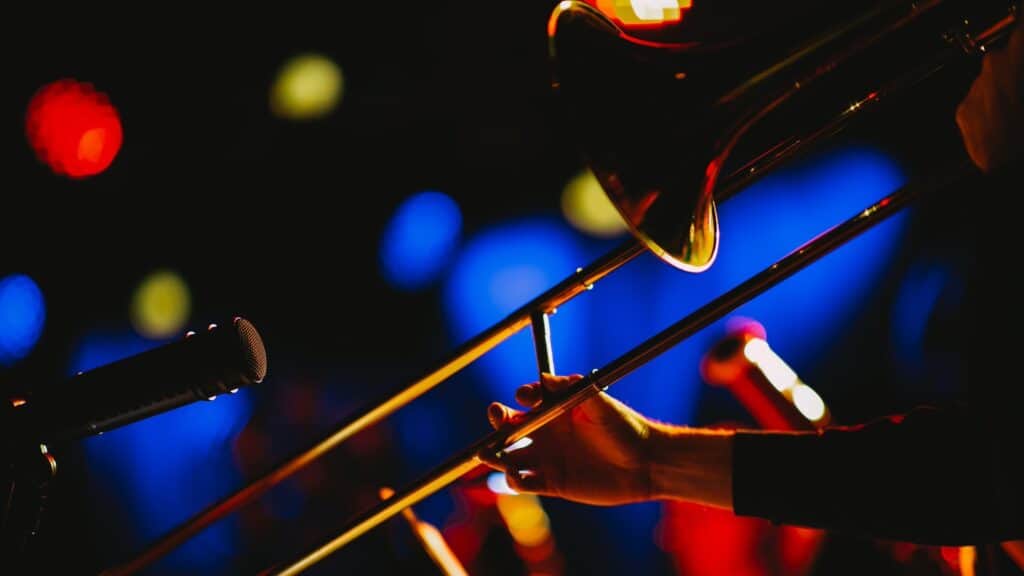
What Is a Jazz Trombone?
The trombone plays a key role in jazz music. Jazz trombones usually have smaller to medium bore sizes. This makes them easier to handle and helps create the right sounds.
Bass trombones add a deeper sound to jazz music. Players in the rhythm section use trombones to keep the beat in songs.
Jazz trombone players use special techniques (like growling and scooping). They also use mutes or effects to change their sound.
A lead trombone player is often the star on stage. They play the main melodies and guide the band through songs.
Jazz trombones are built with thinner walls and bells. This makes them lighter to carry around on stage. They also have smoother slides so players can change notes faster.
How To Start Playing Jazz Music On A Tenor Trombone?
Learning jazz on a trombone takes practice. First, you need to learn the basics of playing this brass instrument.
You should learn how to hold the trombone (I recommend the standard grip). Practice making clear sounds by buzzing your lips into the mouthpiece.
Learn to read music notes and understand rhythms. Work on your slide positions until they become natural movements.
Moving to Jazz
Once you know the basics, start exploring jazz. Listen to famous jazz trombone players like J.J. Johnson or Curtis Fuller.
Practice scales and simple patterns every day. Start with blues scales. Try to play along with slow jazz recordings.
Learn a few easy jazz standards, such as “Autumn Leaves”. Don’t worry about playing fast at first — speed comes with time.
Growing Your Skills
Join a school band or community group. Playing with others makes learning more fun.
Practice different jazz sounds — short notes, long slides, and special effects. Record yourself playing to hear where you need to improve.
Most importantly, have fun!! Jazz is about expressing yourself. With regular practice, you’ll be playing cool jazz solos before you know it.
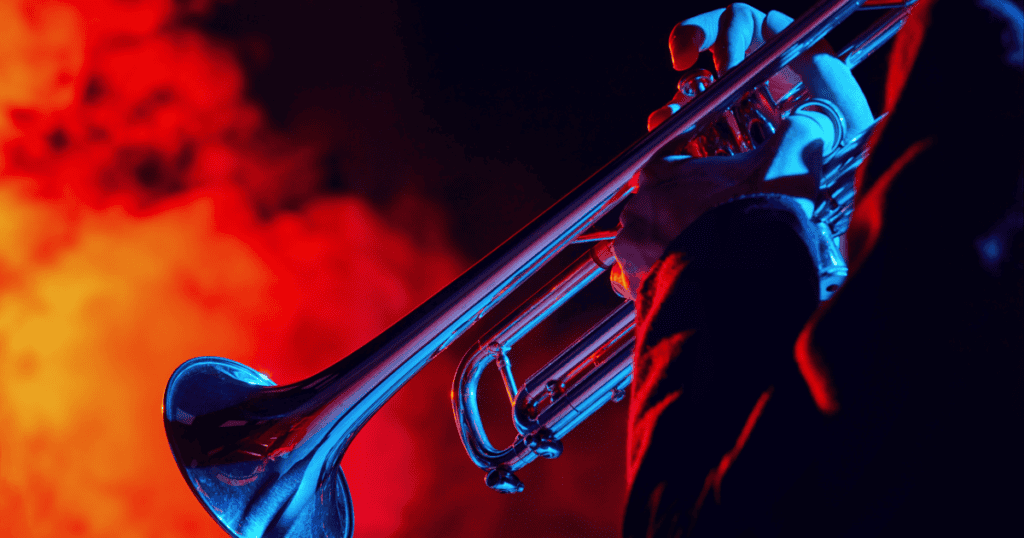
What Makes A Tenor Trombone A Great Jazz Horn?
The trombone is a perfect jazz instrument. It has a wide range of notes and changes its sound easily.
Players can hit high and low notes without trouble. Its bright sound works well with other instruments in a band. Trombones can create fun rhythms and play beautiful solos too!!
This horn fits into many jazz styles (like swing, Latin, and funk). Its rich tone adds character to the music. The slide makes cool gliding sounds and growls that jazz fans love!
Small jazz trombones are great for making up music on the spot. The sliding part gives players many choices for creating new sounds. They can lead the band or support other musicians.
I believe the trombone’s mix of power and grace makes it a STAR in the jazz world!
Conclusion: What Is A Tenor Trombone
Investment in an excellent tenor trombone will speak volumes about your playing skills — no matter the level of experience! An outstanding instrument should project perfectly without sacrificing tone quality or nuance – and tenor trombone truly delivers this.
There is no doubt about it — most trombonists prefer smaller horns to maintain better control and agility when playing the trombone. Practice, experiment, and push yourself until you find that perfect combination between melody and rhythm!
Are you in search of some motivation or mind-blowing trombone performances? Check out this list of 13 Incredible Trombone Players Ever and experience their amazingness! Enjoy!
